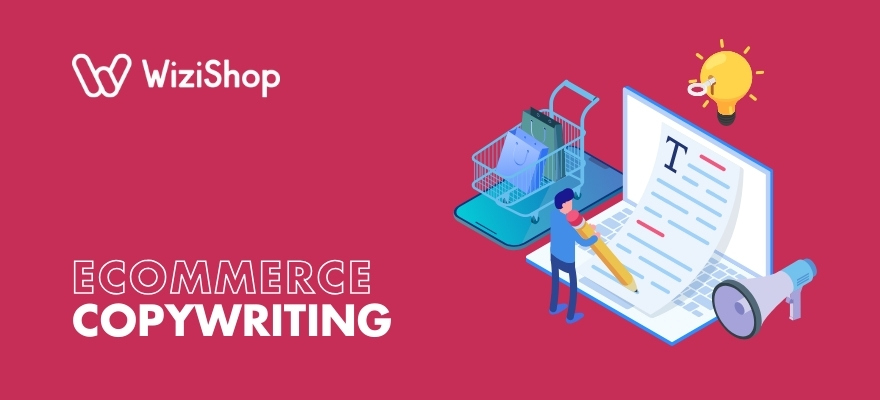Ecommerce copywriting is a critical tool in the arsenal of any e-retailer aiming to captivate and convert visitors into customers. This specialized form of writing goes beyond mere product descriptions; it involves creating persuasive content that not only informs but also engages and convinces potential buyers of the value of your offerings.
Effective ecommerce copywriting can dramatically enhance your web presence, improve search engine rankings, and increase online sales. If you're wondering how to optimize your efforts in this department, you've come to the right place!
This guide will explore the techniques and strategies that can transform your ecommerce copywriting and drive success.
Table of contents
- What is ecommerce copywriting?
- What are the 4 Cs of copywriting?
- What are the benefits of ecommerce copywriting?
- Which of your online store's pages need copywriting?
- Where else can you use ecommerce copywriting?
- Common mistakes to avoid in ecommerce copywriting
- How do you write copy for ecommerce? Tips & best practices
What is ecommerce copywriting?
Ecommerce copywriting involves crafting compelling written content specifically for online stores and platforms. Its purpose is to engage customers, enhance brand identity, and ultimately drive sales.
Effective ecommerce copy can include product descriptions, marketing emails, ads, and blog posts that inform and persuade possible buyers by highlighting product benefits, solving consumer problems, and differentiating an ecommerce business in a competitive market. Good copy is crucial for gaining customers online by making a direct appeal to their needs and desires.
What are the 4 Cs of copywriting?
The 4 Cs of copywriting are principles used to create effective and compelling copy. It' a good idea to keep them in mind to achieve the best ecommerce copywriting possible.
Here's what each "C" represents:
- Clarity: The message should be clear and easy to understand, avoiding jargon and overly complex language. This ensures that readers grasp the intended message without confusion.
- Conciseness: Great copywriting uses the fewest words possible to convey the message. It should be direct and to the point, ensuring that every word serves a purpose.
- Consistency: Copy should maintain a consistent tone, voice, and style across all content to build a cohesive brand identity. Consistency helps establish authority and reassures your audience.
- Credibility: Copywriting should be reliable and backed by facts, data, or testimonials. Credibility builds trust with your audience and encourages them to take action.
What are the benefits of ecommerce copywriting?
Working on a top-notch ecommerce copywriting strategy is a worthwhile activity for companies for a variety of reasons.
- Boosts conversion rates: Well-crafted copy can significantly improve the likelihood of visitors making purchases by clearly communicating product advantages and convincing potential customers of the value offered.
- Enhances search engine optimization (SEO): Effective copywriting includes strategic keyword placement, which helps improve a website's SEO, making it more visible on search engines and drawing more organic traffic.
- Builds brand loyalty: Compelling and consistent copywriting helps establish a brand’s voice and identity, fostering emotional connections with customers, which in turn enhances loyalty and encourages repeat business.
Which of your online store's pages need copywriting?
Your ecommerce site will benefit from copywriting in numerous areas, several of which are described below.
Homepage
Implementing strong copywriting on your homepage is crucial because it forms the first impression and guides potential customers into your sales funnel. Effective copy should clearly communicate what your venture stands for, what you offer, and why consumers should choose you over competitors.
Take Farmacy Beauty's homepage, for example. Right from the get-go, site visitors see a slideshow featuring attractive images with compelling copy that includes action verbs (e.g., "Drench your skin...") along with direct call-to-action (CTA) buttons ("Shop now").

The slideshow also features copy that encourages shoppers to take action ASAP ("Limited quantities only!")

As people scroll down the page, they'll see Farmacy Beauty highlighting several of its best-selling products and promoting its rewards program with well-crafted copy. In addition, there's a succinct section describing what the company is all about.

Product pages
Your product pages will also need plenty of TLC when it comes to ecommerce copywriting, as they can influence purchasing decisions and improve conversion rates. Good copy clearly describes the product's features and perks, answering common customer questions and addressing potential pain points.
When writing the copy for your product pages, be sure to focus on clarity and detail without overwhelming the reader. It's a good idea to highlight the unique selling points of each product and use bullet points for easy readability, as shown in the following example of a product page on Sézane's site.
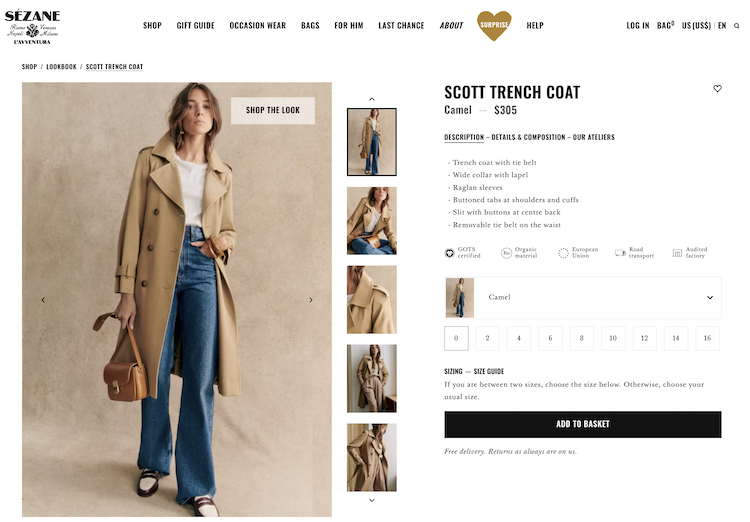
Source: Sézane
To evoke emotions and urgency with your product pages, you may want to consider incorporating convincing language to elicit emotions and urgency. You can also include social proof like customer reviews, testimonials, or mentions of money-back guarantees to increase confidence.
Category pages
The category pages on an ecommerce site serve as an organizational tool that can help customers quickly find groups of related products, bettering the overall shopping experience and reducing bounce rates. Well-written category copy on these pages can improve your Google rankings, boost engagement, and increase conversion rates by providing relevant information that leads visitors through the buying process.
Effective copywriting on category pages entails using clear and concise headings to describe the product group, emphasizing the advantages or unique features that make them desirable.
Don't forget to create brief yet informative descriptions that help customers understand the category's value and add internal links to guide users, as done in the example below on LEGO's site, to specific products or related categories, enhancing site navigation and user experience.
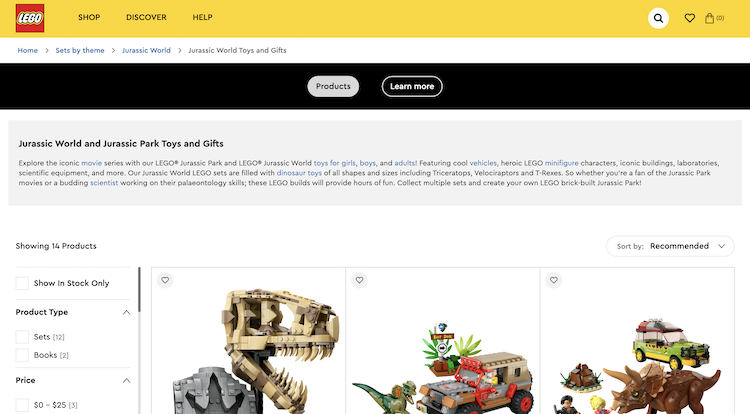
Source: LEGO
"About" page
You'll also want to be sure to use copywriting on your ecommerce site's "About" page, as this is where you'll tell your brand's story, build credibility, and foster a connection with folks visiting your store. A well-crafted "About" page can inspire trust, helping to convert visitors into loyal customers.
To create effective copy for the "About" page, focus on your mission, values, and unique history. Use a conversational tone to engage readers and share what makes your brand special. Include elements like team photos or testimonials to humanize your ecommerce business.
Keep in mind that customers are more likely to return and buy from you again when they feel an emotional connection to your venture's mission and values.
In this "About" page from jewelry company Chupi, for example, the copy concentrates on celebrating the special moments in life rather than putting the emphasis on the company itself.



Source: Chupi
When crafting your business's "About" page, you can also highlight your brand's achievements and contributions to create a sense of reliability. Finally, ensure that the page is visually appealing with a clear structure to facilitate easy reading and exploration.
Landing pages
Despite sometimes being forgotten about by e-merchants, landing pages can be great tools for converting shoppers, even more so when they feature enticing copy!
These are pages specifically designed to drive visitors toward a particular action, such as purchasing a product, signing up for a newsletter, or downloading a resource. Examples of different types of landing pages include product launch pages, promotional pages for special offers, and lead generation pages for collecting customer information.
Although these pages probably won't see as much traffic as other parts of your online store, copywriting is crucial for these pages because people who visit these pages are more likely to turn into loyal customers.
Effective copy should include a strong headline, a clear call-to-action, and concise descriptions that shine a spotlight on the advantages.
Cult Beauty does this well in the following example of a page where people can sign up to be notified via email when the RMS brand's offerings are available on the ecommerce website.
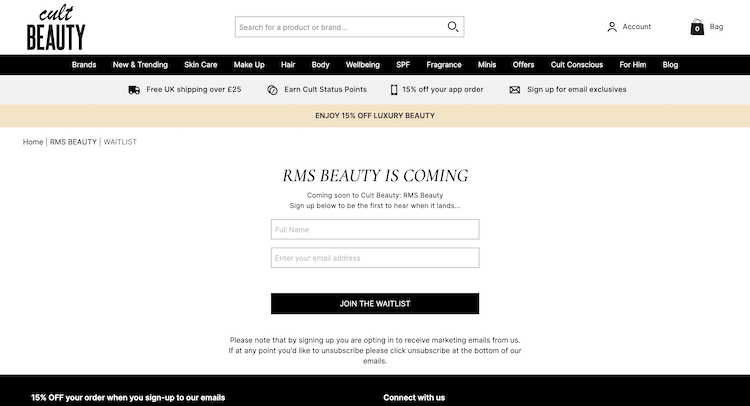
Source: Cult Beauty
The copy on the page creates a sense of exclusivity ("Sign up below to be the first to hear when it lands...") and informs consumers why they should subscribe to the email newsletter ("15% OFF your order when you sign-up to our emails").
To optimize landing page copywriting, focus on clarity, use persuasive language, and create a sense of urgency where appropriate. It's also advantageous to incorporate customer testimonials or reviews when applicable, and verify that your copy is consistent with your brand voice and overall ecommerce marketing strategy.
Blog
Writing high-quality, informative blog posts is part of any effective strategy for ecommerce content marketing.
Your online store's blog can use ecommerce copywriting to create engaging, informative, and convincing content that resonates with readers. It serves as a platform to showcase product insights, industry trends, and helpful tips, ultimately driving organic traffic and building brand credibility.

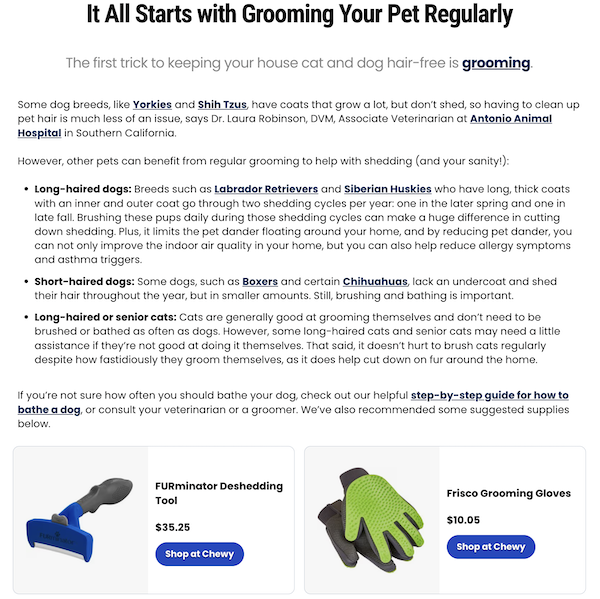
Example of a blog post using ecommerce copywriting on Chewy's blog
Effective ecommerce copywriting in blog posts employs clear language, compelling storytelling, and strategic use of keywords for search engine optimization. This approach helps convert blog readers into customers and fosters a loyal online community.
You can also include visuals, such as images or infographics, to enhance engagement and encourage interaction by ending with a question or a CTA, prompting readers to comment or explore related content.
Where else can you use ecommerce copywriting?
Your online store isn't the only place where copywriting will come in handy! Here are a few other areas where adding compelling copy can be beneficial for your ecommerce business.
Email marketing
Copywriting is vital for email marketing because it directly influences how recipients perceive your brand and respond to your messages. Effective copy can drive engagement, boost open rates, and increase conversions by delivering relevant and compelling content to your readers.
When it comes to optimizing your copywriting strategy with your email campaigns, be sure to start with a captivating subject line that entices recipients to open the email. Keep your content concise and focused, emphasizing the advantages and value for the reader. Remember to personalize emails with customer names or segmented content to make them feel valued.
Social media
By implementing effective copywriting on social media networks, you'll be able to engage with a wider range of consumers, build brand awareness, and drive traffic to your ecommerce website. Well-crafted social media copy can capture attention in a crowded digital space and encourage interactions that lead to sales.
As you craft your posts for social media, focus on creating short, punchy content that resonates with your target market. Use compelling headlines or hooks to grab attention, include easy-to-understand CTAs, and incorporate visuals, like images or videos, to enhance engagement. You can also utilize hashtags strategically to increase visibility and reach, and engage with your followers by responding to comments and messages.
Paid ads
If you plan to include paid ads in your marketing strategy, you'll want to take copywriting into consideration here as well. This is due to the fact that it will directly influence the effectiveness of your advertising campaigns, impacting click-through rates and conversions.
High-quality copy can attract attention, spark interest, and encourage users to take action, maximizing your return on investment. To make your ads as powerful as possible, aim to write concise and compelling headlines that immediately capture attention. Highlight what differentiates your product or service from others on the market and write in a manner that evokes emotions that drive action.
In addition, tailor your messaging to your audience's preferences and behaviors for better relevance. Don't hesitate to regularly test and optimize elements such as headlines and CTAs for improved performance.
Common mistakes to avoid in ecommerce copywriting
Overusing jargon
Using too much industry-specific language can confuse customers who might not be familiar with technical terms, making the content less accessible and engaging. Jargon-heavy language creates a barrier to understanding, making it difficult for visitors to grasp the benefits of your products or services.
This lack of clarity can lead to decreased engagement and higher bounce rates. To avoid this, use clear, simple language that resonates with your buyer persona, ensuring that your text is accessible and easily understood.
Poorly structuring your content
No matter how compelling your copy is, if it's structured in a way that makes it difficult for people to navigate and understand your message, it won't be very beneficial for your business. Long, unbroken blocks of text or disorganized information can overwhelm readers.
It's important to avoid this by using a clear and logical structure with concise paragraphs, descriptive headings, and bullet points where appropriate. This improves readability, keeps users engaged, and encourages them to explore further.
Not showing any personality
Not showing any personality in your copywriting can make your content dull and not very engaging. When copy lacks character, it feels robotic, failing to connect with customers on an emotional level. This can lead to reduced interest and lower conversion rates.
Aim to instead infuse your copy with a unique brand voice that reflects your values and resonates with your audience. This human touch can build customer trust and encourage engagement.
Failing to address your target audience
In order to create compelling copy, thorough research is crucial, as you need to understand your paying customers' motivations and obstacles.
Trying to appeal to too many people dilutes your message and makes it less compelling. By casting too wide a net, you risk losing relevance and not connecting with the specific needs, desires, and pain points of your core customers.
Never updating the copy on your website
Markets are in a constant state of flux, and so is your buyer persona. The language your ideal customer used just a few years ago may no longer be applicable, indicating that you should regularly update your website copy.
Never updating the copy on your ecommerce website can make your content outdated, less relevant to customers, and ineffective for search engine optimization. As trends, consumer preferences, and product offerings evolve, static copy may fail to engage consumers, reduce search engine visibility, and negatively impact conversions.
How do you write copy for ecommerce? Tips & best practices
Know your audience
Having a good understanding of your audience enables you to create content that resonates with your target customers, addressing their needs, preferences, and pain points.
To get to know your audience, start by analyzing your website analytics to understand user demographics, behavior, and interests. Conduct surveys or interviews to gather direct feedback from customers.
Use social media listening tools to monitor conversations about your industry and company. You can then create buyer personas based on this data to visualize your ideal buyers, helping you tailor your copywriting to meet their expectations and desires.
Use clear and concise language
Customers have limited time and attention spans, so complex or lengthy content can cause them to lose interest, leading to missed sales opportunities. Clear and concise copywriting eliminates confusion, allowing customers to quickly understand why they should buy your product or service.
To increase your chances of success with your copywriting involving internet commerce, aim for brevity and avoid jargon or technical terms that might confuse your audience. Use short sentences and paragraphs, and structure your content with clear headings and bullet points for easy scanning.
Employ straightforward language that directly addresses customer needs and use active voice to maintain clarity and energy in your writing. This in turn will likely lead to better engagement and higher conversion rates.
Highlight benefits, not just features
Focusing on the value your product or service provides allows you to connect with shoppers in a deeper way, demonstrating how your offering improves their lives or solves their problems.
Features describe what a product does, but benefits explain why it matters to the customer. By concentrating on these aspects, you create a stronger emotional appeal, which can lead to higher conversion rates and greater customer satisfaction.
To do this, first identify the needs and desires of your audience. Then, translate each feature into a tangible benefit by asking, "What does this feature enable the customer to do?"
For example, instead of saying, "Our phone has a 4000mAh battery," explain the benefit: "Stay connected all day without recharging." This approach helps consumers see the real value in your product, encouraging them to take action.
Include compelling CTAs
Clear and persuasive CTAs play an important role in successful copywriting. A well-crafted CTA creates a sense of urgency or excitement, motivating users to take immediate action. Without strong CTAs, customers might feel unsure about what to do next, leading to missed sales opportunities and higher bounce rates.
When creating your CTAs, be sure to use action-oriented language that clearly indicates what the user should do, such as "Buy Now," "Get Started," or "Download Here." You can also make your CTAs visually distinct with contrasting colors, bold fonts, or buttons to draw attention.
Position them strategically throughout your content, especially at the end of sections or pages. Consider personalizing yoru CTAs as well to make them more relevant to the user, increasing the likelihood of conversion.
Optimize for SEO
When it comes to the copy on your web commerce site, you definitely don't want to forget about SEO! This valuable lever enhances your online store's visibility, attracting more organic traffic from search engines like Google.
Improved visibility boosts the likelihood of consumers discovering your products, leading to higher engagement and conversion rates. Search engine optimization also contributes to establishing authority in your niche, building trust with shoppers.
Here are few things you can do to improve your SEO:
- Conduct keyword research to identify relevant terms and phrases used by your target audience.
- Incorporate these keywords naturally into your copy, including headlines, product descriptions, and meta tags.
- Use descriptive and unique meta descriptions to boost click-through rates.
- Ensure that your content has a clear structure with defined headings and subheadings for easier indexing.
- Regularly update your content to keep it fresh and maintain your rankings on search engines.
Harness the power of storytelling
Stories create emotional connections, making you and products more relatable. A compelling narrative can engage customers, highlight your values, and differentiate you from competitors. Stories also help convey complex information in an accessible way, establishing confidence and encouraging customers to take action.
To use storytelling effectively, concentrate on customer-centric stories that reflect real experiences or showcase how your products solve specific problems. Craft a clear narrative with a beginning, middle, and end, guiding readers through the journey. Remember to highlight the human element—such as testimonials, brand history, or customer success stories—to foster a deeper connection.
Keep adjectives to a minimum
Although it's wonderful to be descriptive in your text, excessive use of adjectives can lead to vague or exaggerated descriptions that undermine credibility. When ecommerce copy is overloaded with adjectives, it can become hard to read and less convincing, as readers might view it as hyperbole or marketing fluff. Limiting adjectives and using fewer words can help maintain clarity and focus on the actual benefits of your products or services.
Try to choose descriptive words that add genuine value and avoid unnecessary embellishments. Instead of relying on adjectives, emphasize specific features and outcomes that matter to customers. Use strong verbs to convey action and advantages, and let customer testimonials or reviews provide the additional context.


